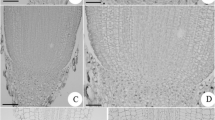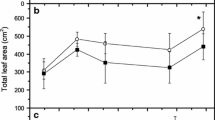Abstract
Accurate knowledge about factors and conditions determining copper (Cu) toxicity in soil is needed for predicting plant growth in various Cu-contaminated soils. Therefore, effects of Cu on growth (biomass production) of lettuce (Lactuca sativa) were tested on seven selected, very different soils spiked with Cu and aged for 2 months at 35 °C. Cu toxicity was expressed as pEC50(Cu2+), i.e., the negative logarithm of the EC50(Cu2+) activity to plant growth. The determined pEC50(Cu2+) was significantly and positively correlated with both the analytically readily available soil pH and concentration of dissolved organic carbon [DOC] which together could explain 87 % of the pEC50(Cu2+) variation according to the simple equation: pEC50(Cu2+) = 0.98 × pH + 345 × [DOC] − 0.27. Other soil characteristics, including the base cation concentrations (Na+, K+, Ca2+, Mg2+), the cation exchange capacity at soil pH (ECEC), and at pH 7 (CEC7), soil organic carbon, clay content, and electric conductivity as well as the distribution coefficient (Kd) calculated as the ratio between total soil Cu and water-extractable Cu did not correlate significantly with pEC50(Cu2+). Consequently, Cu toxicity, expressed as the negative log of the Cu2+ activity, to plant growth increases at increasing pH and DOC, which needs to be considered in future management of plant growth on Cu-contaminated soils. The developed regression equation allows identification of soil types in which the phytotoxicity potential of Cu is highest.



Similar content being viewed by others
References
Allen HE, Yanqing L, Di Toro DM (2008) Ecotoxicity of Ni in soil. Mineral Mag 72:367–371
Arnold WR, Diamond RL, Smith DS (2010) The effects of salinity, pH, dissolved organic matter on acute copper toxicity to the rotifer, Brachionus plicatilis (“L” strain). Arch Environ Contam Toxicol 59:225–234
Ashworth DJ, Alloway BJ (2007) Complexation of copper by sewage sludge-derived dissolved organic matter: effects on soil sorption behaviour and plant uptake. Water Air Soil Pollut 182:187–196
Awadzi TW, Bredwa-Mensah Y, Breuning Madsen H, Boateng E (2001) A scientific evaluation of the agricultural experiments at Frederiksgave, the royal Danish plantation on the Gold Coast, Ghana. Danish J Geogr 101:33–41
Brandt KK, Frandsen RJN, Holm PE, Nybroe O (2010) Development of pollution-induced community tolerance is linked to structural and functional resilience of a soil bacterial community following a five-year field exposure to copper. Soil Biol Biochem 42:748–757
Campbell PGC, Twiss MR, Wilkinson KJ (1997) Accumulation of natural organic matter on the surfaces of living cells: implications for the interaction of toxic solutes with aquatic biota. Can J Fish Aq Sci 54:2543–2554
Chapman HD (1965) Cation-exchange capacity. In: Black CA (ed) Methods of soil analysis. part 1, chemical and microbiological properties. Amer. Soc. Agron, Madison, pp 891–901
Christiansen KS, Holm PE, Borggaard OK, Hauschild MZ (2011) Addressing speciation in the effect factor for characterisation of freshwater ecotoxicity—the case of copper. Int J Life Cycle Assess 16:761–773
Degryse F, Smolders E, Parker DR (2009) Partitioning of metals (Cd, Co, Cu, Ni, Pb, Zn) in soils: concepts, methodologies, prediction and applications—a review. Europ J Soil Sci 60:590–612
Finnveden G, Hauschild MZ, Ekvall T, Guinée J, Heijungs R, Hellweg S, Koehler A, Pennington D, Suh S (2009) Recent developments in life cycle assessment. J Environ Manag 91:1–21
Gustafsson JP (2007) Visual Minteq. http://www.lwr.kth.se/english/OurSoftWare/Vminteq/
Hauschild M (2005) Assessing environmental impacts in a life cycle perspective. Environ Sci Technol 39:81A–88A
Kinniburgh DG, van Riemsdijk WH, Koopal LK, Borkovec M, Benedetti MF, Avena MJ (1999) Ion binding to natural organic matter: competition, heterogeneity, stoichiometry and thermodynamic consistency. Colloids Surf A 151:147–166
Kinraide TB (2006) Plasma membrane surface potential (psi(PM)) as a determinant of ion bioavailability: a critical analysis of new and published toxicological studies and a simplified method for the computation of plant psi(PM). Environ Toxicol Chem 25:3188–3198
Le YTT, Peijnenburg WJGM, Hendriks AJ, Vijver MG (2012) Predicting effects of cations on copper toxicity to lettuce Lactuca sativa by the biotic ligand model. Environ Toxicol Chem 31:355–359
Lock K, Janssen CR (2001) Test designs to assess the influence of soil characteristics on the toxicity of copper and lead to the Oligochaete Enchytraeus albidus. Ecotoxicol 10:137–144
Moberg JP, Petersen L, Rasmussen K (1988) Constituents of some widely distributed soils in Denmark. Geoderma 42:295–316
Msolla MM, Semoka JMR, Szilas C, Borggaard OK (2007) Crop (Maize) response to direct application of local phosphate rock on selected acid soils of Tanzania. Commun Soil Sci Plant Anal 38:93–106
Nowack B, Schulin R, Robinson BH (2006) Critical assessment of chelant-enhanced metal phytoextraction. Environ Sci Technol 40:5225–5232
Qiu H, Vijver MG, He E, Peijnenburg WJGM (2013) Predicting copper toxicity to different earthworm species using a multicomponent Freundlich model. Environ Sci Technol 47:4796–4803
Rachou J, Gagnon C, Sauvé S (2007) Use of ion-selective electrode for free copper measurements in low salinity and low ionic strength matrices. Environ Chem 4:90–97
Rooney CP, Zhao FJ, Mcgrath SP (2006) Soil factors controlling the expression of copper toxicity to plants in a wide range of European soils. Environ Toxicol Chem 25:726–732
Sauvé S, McBride MB, Norvell WA, Hendershot W (1997) Copper solubility and speciation of in situ contaminated soils: effects of copper level, pH and organic matter. Water Air Soil Pollut 100:133–149
Smolders E, Oorts K, Van Sprang P, Schoeters I, Janssen CR, Mcgrath SP, McLaughlin MJ (2009) Toxicity of trace metals in soil as affected by soil type and aging after contamination: using calibrated bioavailability models to set ecological soil standards. Environ Toxicol Chem 28:1633–1642
Soil Survey Staff (2010) Key to soil taxonomy. Department of Agriculture, National Resource Conservation Service, Washington
Song J, Zhao FJ, Luo YM, Mcgrath SP, Zhang H (2004) Copper uptake by Elsholtzia splendens and Silene vulgaris and assessment of copper phytoavailability in contaminated soils. Environ Pollut 128:307–315
Steenbergen NTTM, Iaccino F, De Winkel M, Reijnders L, Peijnenburg WJGM (2005) Development of a biotic ligand model and a regression model predicting acute copper toxicity to the earthworm Aporrectodea caliginosa. Environ Sci Technol 39:5694–5702
Thakali S, Allen HE, Di Toro DM, Ponizovsky AA, Rooney CP, Zhao FJ, McGrath SP, Criel P, Van Eeckhout H, Janssen CR, Oorts K, Smolders E (2006) Terrestrial biotic ligand model. 2. Application to Ni and Cu toxicity to plants, invertebrates, and microbes in soil. Environ Sci Technol 40:7094–7100
Van Hees PAW, Jones DL, Finlay R, Godbold DL, Lundström US (2005) The carbon we do not see—the impact of low molecular weight compounds on carbon dynamics and respiration in forest soils: a review. Soil Biol Biochem 37:1–13
Voigt A, Hendershot WH, Sunahara GI (2006) Rhizotoxicity of cadmium and copper in soil extracts. Environ Toxicol Chem 25:692–701
Wang XD, Ma YB, Hua L, McLaughlin MJ (2009) Identification of hydroxyl copper toxicity to barley (Hordeum vulgare) root elongation in solution culture. Environ Toxicol Chem 28:662–667
Wang P, Menzies NW, Wang YM, Zhou DM, Zhao FJ, Kopittke PM (2012) Identifying the species of copper that are toxic to plant roots in alkaline nutrient solutions. Plant Soil 361:317–327
Wolt JD (1994) Soil solution chemistry: applications to environmental science and agriculture. Wiley, New York
Wu Y, Hendershot WH (2010) Effect of calcium and pH on copper binding and rhizotoxicity to pea (Pisum sativum L.) root: empirical relationships and modeling. Arch Environ Contam Toxicol 59:109–119
Zhang X, Wang X, Wei D, Li B, Ma Y, Huang Z (2013) The influence of soil solution properties on phytotoxicity of soil soluble copper in a wide range of soils. Geoderma 211–212:1–17
Acknowledgments
The scholarship supported by the Residual Resources Research (3R) graduate school (www.3r.er.dtu.dk) is acknowledged.
Author information
Authors and Affiliations
Corresponding author
Additional information
Responsible editor: Elena Maestri
Electronic supplementary material
Below is the link to the electronic supplementary material.
Fig. S1
Relationship between measured pCu (pCuISE) and calculated pCu in water extracts based on 75 Cu-spiked Dutch soil samples (W.J.G.M. Peijnenburg, Unpublished results). The solid line represents the linear regression line. (DOCX 25 kb)
Fig. S2
The observed EC50(Cu2+) and the EC50 (Cu2+) calculated (predicted) by the pH-dependence (pEC50(Cu2+) = 0.86×pH + 1.48) reported by Le et al. (2012) for root elongation of lettuce (Lactuca sativa) grown in hydroponic solution. R2 = 0.55, n =7. (DOCX 48 kb)
Table S1
Data from Zhang et al. (2013) including pH and DOC concentration of pore water samples from 17 Cu-spiked, Chinese soils together with pEC50(Cu2+) calculated by Visual Minteq (pEC50(Cu2+){Zhang}) and by means of Eq. 2 (pEC50(Cu2+){KSC}). (DOCX 15 kb)
Rights and permissions
About this article
Cite this article
Christiansen, K.S., Borggaard, O.K., Holm, P.E. et al. Experimental determinations of soil copper toxicity to lettuce (Lactuca sativa) growth in highly different copper spiked and aged soils. Environ Sci Pollut Res 22, 5283–5292 (2015). https://doi.org/10.1007/s11356-014-3737-3
Received:
Accepted:
Published:
Issue Date:
DOI: https://doi.org/10.1007/s11356-014-3737-3




